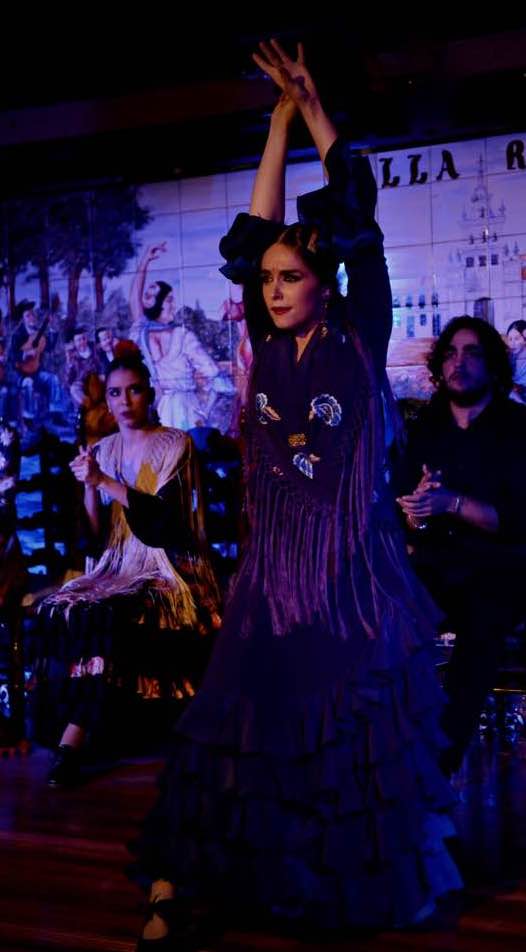The Tablao: Where flamenco dancers are made - Vancouver Ballet Society
- Home
- Features 2020 - 2023
- The Tablao: Where flamenco dancers are made

By Bridgit Lujan
People come to Spain from all over the world to witness authentic flamenco in the iconic performance space known as the tablao. This small cabaret-like theatre, with an acoustic stage and limited seating, allows audiences to have an up close and personal experience of flamenco.
Typically thought of as being found throughout Spain, flamenco is actually concentrated primarily in the southern region of Andalucía (where flamenco was born) and in Spain’s two largest cities, Barcelona and Madrid. Madrid is literally the “landing point” for most international visitors, who make up the majority of flamenco’s audience. As the gateway city, Madrid has developed sought-after flamenco venues such as Corral de la Morería, Casa Patas, Café de Chinitas, Tablao Villa Rosa, and Cardamomo.

Tablaos provide essential jobs for artists, as well as opportunities for experimentation, the development of musical instinct, athleticism, and individual creativity. Performing in the tablao setting is how dancers gain and maintain these essential skills. Even the most elite of flamenco performers seek the tablao to prepare for their more high-profile tours, festivals, and theatre shows.
Paula Rodríguez, resident dancer at Cardamomo and 2021 winner of one of the most coveted flamenco dance prizes, the “Despante” from the Cante de las Minas competition, says, “The tablao is the place where you can best find your style and develop your personality as a dancer. In the tablao you are exposed to situations of challenging improvisation where success and error are presented to you daily. Thanks to that challenge you learn and evolve.”

Dancing with live music requires strong instincts, and flamenco dancers are required to do more than just dance. While delivering highly virtuosic movement and physical expression, they also contribute musically: their percussive footwork is part of the instrumental jam as musicians and dancers play off one another rhythmically.
The studio teaches dancers form, technique, gesture, and musical structure, but the final step of bringing all the elements together in a performance is developed from engaging in the process night after night in the tablao. Flamenco’s vibrancy and allure is rooted in its spontaneity, and dancers have to be quick problem solvers of the unexpected.
Ángel Atienza, veteran dancer and director of his own flamenco school, says, “The non-verbal dialogue that is created onstage between the dancer and the other artists is something that can be explained conceptually in a class, but can only be internalized in the tablao. A dance will never be the same as it was learned or rehearsed because the musicians play and sing differently every performance.”
Flamenco also requires a great deal of physical strength. To be able to share inner emotions, the dancer cannot feel strained, they must have physical prowess that surpasses the demands of the dance. The muscular and aerobic strength built from nightly tablao performances cannot be matched by rehearsing in a studio or even cross-training.
Since the start of the pandemic, however, tablaos known all over the world, with decades of history, have hit hard times, with Madrid making headlines with the permanent closures of Casa Patas and Tablao Villa Rosa. Demands on the Minister of Culture and Sports to save the emblematic cultural heritage went primarily without response, and periodicals from New York to Australia were reporting that flamenco was in peril of being permanently lost.
These venues were caught in the crosshairs, regarded as for-profit restaurants that were not eligible for any type of government support. Despite flamenco being recognized as an Intangible Heritage by UNESCO in 2010, the tablaos that are crucial to the well-being of the art form do not receive the kind of support that a museum might even though they have a principle role in preservation.
Against the odds, June 2021 brought hope with the opening of a new tablao, La Carmela. And Tablao Villa Rosa, which had announced it was closing permanently last year, re-opened in April 2022. Flamenco has once again proven its resilience, which is the essence of the dance.

